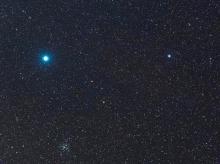Listen to today's episode of StarDate on the web the same day it airs in high-quality streaming audio without any extra ads or announcements. Choose a $8 one-month pass, or listen every day for a year for just $30.
You are here
The Dog’s Head
The stars that outline the head of the big dog are all late in life. But that doesn’t mean they’re the same age. In fact, their ages vary by about 10 billion years.
Canis Major, the big dog, is in the southeast as night falls. It’s home to Sirius, the brightest star in the night sky.
The head forms a triangle to the left of Sirius during the early evening, and above it later on. None of the stars is much to look at. If you lined them up at the same distance as Sirius, though, they’d far outshine it.
The snout is marked by Theta Canis Majoris. It’s about 260 light-years away. The star at the ear is Gamma Canis Majoris. It’s a couple of hundred light-years farther. And the star that connects the head and neck — Iota Canis Majoris — is more than 3,000 light-years away.
All three stars are at or near the ends of their lives. Because they have different masses, though, they’ve taken different lengths of time to reach that point.
Iota is the heaviest, so it burned through its nuclear fuel much faster. It’s only 15 million years old, but its life is almost over. And it’s likely to end with a bang — as a supernova.
Theta is the least massive, so it’s lived the longest — 10 billion years. It will end by expelling its outer layers, leaving its dead core — a white dwarf. Gamma is between the ages of the other two, and it faces the same future as Theta — the same fate that awaits the Sun in five billion years.
Script by Damond Benningfield





